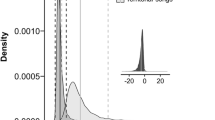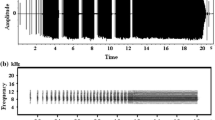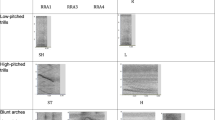Abstract
In this study we investigated the phylogenetic, morphological and ecological factors affecting the caw calls of 28 species of the genus Corvus, spanning the worldwide range of the taxon. The three phylogeographic groups identified by Goodwin (1986, Crows of the World, British Museum (Natural History), St Edmudsbury Press, Bury St Edmunds), i.e. the American stock, the Palearctic-African stock and the Oriental-Australian stock, were differentiated by some of the acoustic features of their calls, suggesting that historical factors may have played an important role in the evolution of vocalisations in this group. To assess the effects of morphology (body size and bill length) and environment (open vs. closed habitat) and to simultaneously take into account the phylogenetic effects, we used the phylogenetically independent contrast method. This manner of analysis revealed that body size was important in shaping the acoustic attributes of the caw call, as it influenced two temporal and two spectral variables, whereas the effect of bill length was far weaker. Notably, our results did not confirm the negative correlation between call frequency and body size that resulted in a phylogeny-free analysis of the same data in many studies on passerines. Larger Corvus species, in fact, utter calls with higher fundamental frequency than those of smaller species. Hence, these results show that incorporating phylogeny in analyses can substantially alter the conclusions reached by studies carried out with non-phylogenetic approaches. The acoustic environment, considered one of the most important forces driving the evolution of vocalisations in passerines, slightly influenced only two acoustic parameters in the Corvusgenus, call fundamental frequency and duration of pulsed units, both of which increased in the calls of forest species.
Similar content being viewed by others
References
Badyaev, A.V. and Leaf, E.S. (1997) Habitat associations of song characteristics in Phylloscopus and Hippolais warblers. Auk 114, 40–46.
Bowman, R.I. (1979) Adaptive morphology of song dialects in Darwin's finches. J. Ornithol. 120, 353–389.
Brown, E.D. (1985) The role of song and vocal imitation among common crows (Corvus brachyrhynchos). Z. Tierpsychol. 68, 115–136.
Cramp, S. and Perrins, C.M. (1994) The Birds of the Western Palearctic. Vol. VIII. Oxford University Press, Oxford.
De Kort, S.R. and Ten Cate, C. (2001) Response to interspeci.c vocalizations is a.ected by degree of phylogenetic relatedness in Streptopelia doves. Anim. Behav. 61, 239–247.
Felsenstein, J. (1985) Phylogenies and the comparative method. Am. Nat. 125, 1–25.
Felsenstein, J. (1988) Phylogenies and quantitative characters. Ann. Rev. Ecol. Syst. 19, 445–471.
Garland, T., Harvey, P.H. and Ives, A.R. (1992) Procedures for the analysis of comparative data using phylogenetically independent contrasts. Syst. Biol. 41, 18–32.
Garrido, O.H., Reynard, G.B. and Kirkconnell, A. (1997) Is the palm crow, Corvus palmarum (Aves: Corvidae), a monotypic species? Ornithol. Neotrop. 8, 15–21.
Goodwin, D. (1986) Crows of the World. British Museum (Natural History), St Edmudsbury Press, Bury St Edmunds.
Gosler, A.G., Greenwood, J.J.D., Baker, J.K. and Davidson, N.C. (1998) The field determination of body size and condition in passerines: a report to the British Ringing Committee. Bird Study 45, 95–103.
Greenwalt, C.H. (1968) Bird Song: Acoustics and Physiology. Smithsonian Institution Press, Washington, DC.
Harvey, P.H. and Purvis, A. (1991) Comparative methods for explaining adaptations. Nature 351, 619–624.
Hoese, W.J., Podos, J., Boetticher, N.C. and Nowicki, S. (2000) Vocal tract function in birdsong production: experimental manipulation of beak movements. J. Exp. Biol. 203, 1845–1855.
Laiolo, P. and Rolando, A. (2003) Comparative analysis of the rattle calls in Corvus and Nucifraga: the effect of body size, bill size, and phylogeny. The Condor 105, in press.
Laiolo, P., Rolando, A., Delestrade, A. and De Sanctis, A. (2001a) Geographical variation in the calls of the Choughs. The Condor 103, 287–297.
Laiolo, P., Rolando, A., Delestrade, A. and De Sanctis, A. (2001b) Geographic diversification in the call repertoire of the genus Pyrrhocorax (Aves, Corvidae). Can. J. Zool. 1568–1576.
Madge, S. and Burn, H. (1994) Crows and Jays. Christopher Helm Publisher. London.
Martens, J. (1996) Vocalizations and Speciation of Palearctic Birds. In D.E. Kroodsma and E.H. Miller (eds) Ecology and Evolution of Acoustic Communication in Birds. Cornell University Press, Ithaca and London, pp. 221–240.
Martens, J., Böhner, J. and Hammerschmidt, K. (2000) Calls of the Jungle Crow (Corvus macrorhynchos s.l.) as a taxonomic character. J. Ornithol. 141, 275–284.
McCracken, K.G. and Sheldon, F.H. (1997) Avian vocalization and phylogenetic signal. Proc. Nat. Acad. Sci. United States Am. 94, 3833–3836.
Miller, E.H., Gunn, W.W.H. and Veprintsev, B.N. (1988) Breeding vocalizations of Baird's Sandpiper Calidris bairdii and related species, with remarks on phylogeny and adaptation. Ornis Scandinav 19, 257–267.
Morton, E.S. (1975) Ecological sources of selection on avian sounds. Am. Nat. 109, 17–34.
Nowicki, S. and Marler, P. (1988) How do birds sing? Music Percep. 5, 391–426.
Nowicky, S. (1987) Vocal tract resonances in oscine bird sound production: evidence from bird songs in a helium atmosphere. Nature 325, 53–55.
Palacios, M.G. and Tubaro, P.L. (2000) Does beak size affect acoustic requencies in woodcreepers? The Condor 102, 553–560.
Payne, R.B. (1986) Bird songs and avian systematics. In R.J. Johnston (ed.) Current Ornithology. Plenum Press, New York, pp. 87–126.
Podos, J. (1997) A performance constraint on the evolution of trilled vocalizations in a songbird family (Passeriformes: Emberizidae). Evolution 51, 537–551.
Purvuis, A. and Rambaut, A. (1995) Comparative analysis by independent contrasts (CAIC): an Apple Macintosh application for analysing comparative data. Comp. Appl. Biosci. 11, 247–251.
Richards, D.G. and Wiley, R.H. (1980) Reverberation and amplitude fluctuations in the propagation of sound in forest: implication for animal communication. Am. Nat. 115, 381–399.
Røskaft, E. and Espmark, Y. (1982) Vocal communication by the Rook Corvus frugilegus during the breeding season. Ornis. Scandinav. 13, 38–46.
Ryan, M.J. (1988) Constraints and Patterns in the Evolution of Anuran Acoustic Communication. In Fritzsch B. (ed.) The Evolution of the Amphibian Auditory System. John Wiley and Sons, Inc., pp. 637–678.
Ryan, M.J. and Brenowitz, E.A. (1985) The role of body size, phylogeny, and ambient noise in the evolution of bird song. Am. Nat. 126, 87–100.
Tchernichovski, O., Nottebohm, F., Ho, C.E., Pesaran, B. and Mitra, P.P. (2000) A procedure for an automated measurement of song similarity. Anim. Behav. 59, 1167–1176.
Tubaro, P.L. and Mahler, B. (1998) Acoustic frequencies and body mass in New World doves. The Condor 100, 54–61.
Wallschläger, D. (1980) Correlation of song frequency and body weight in passerine birds. Experientia 36, 412.
Ward, D. (2000) Do polyandrous shorebirds trade off egg size with egg number? Journal of Avian Biology 31, 473–478.
Wiley, R.H. (1991) Associations of song properties with habitats for territorial oscine birds of eastern North America. Am. Nat. 138, 973–993.
Wiley, R.H. and Richards, D.G. (1978) Physical constraints on acoustical communication in the atmosphere: implications for the evolution of animal vocalizations. Behav. Ecol. Sociobiol. 3, 69–94.
Wiley, R.H. and Richards, D.G. (1982) Adaptations for acoustic communication in birds: sound transmission and signal detection. In D. Kroodsma and E. Miller (eds) Acoustic Communication in Birds. Academic Press, New York, pp. 131–181.
Author information
Authors and Affiliations
Rights and permissions
About this article
Cite this article
Laiolo, P., Rolando, A. The evolution of vocalisations in the genus Corvus: effects of phylogeny, morphology and habitat. Evolutionary Ecology 17, 111–123 (2003). https://doi.org/10.1023/A:1023003110969
Issue Date:
DOI: https://doi.org/10.1023/A:1023003110969




